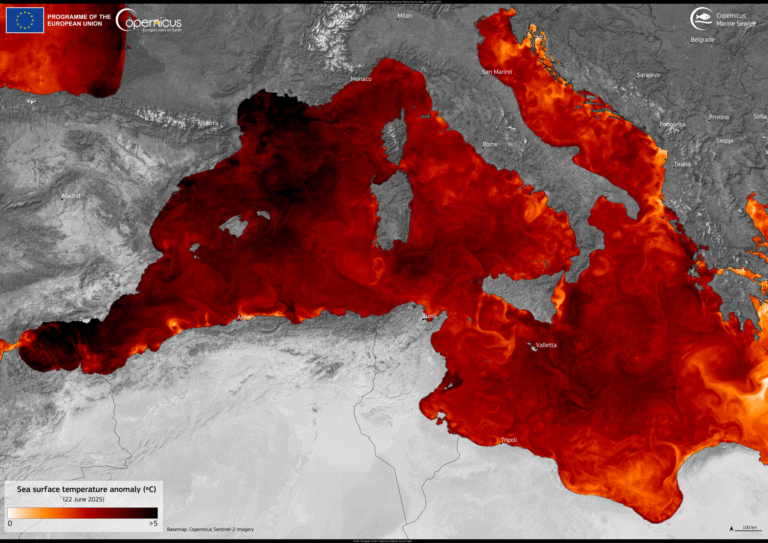How Measuring Urban Water Consumption Can Help Cut Carbon Emission
Most of us don’t link water usage to carbon emissions. But the amount of avoidable excess water used in an…
According to reports, 2.4 billion workers are exposed to unsafe levels of heat at work.
Jhalak Jain

Global temperatures are rising and extreme weather is becoming more frequent, creating ripple effects across economies and industries. Climate-driven fixed asset losses are projected to cut average company earnings by 6.6–7.3% by 2035, a burden that will only grow if unchecked. These shocks strain energy systems, disrupt trade and logistics, and damage crops and industrial assets. Treating climate risk as separate from business strategy is no longer viable; it is a direct economic and operational challenge for agriculture, manufacturing, tech, retail, and finance.

Heatwaves in Europe, June, 2025. Source: Wikipidea
When temperatures soar, it is employees who bear the brunt. Prolonged heat exposure leads to fatigue, dehydration, and heat-related illnesses. For industries like manufacturing, logistics, and agriculture, this creates serious health and safety concerns. Recent reports show that nearly 80% of the global workforce, i.e., almost 2.4 billion workers are exposed to unsafe levels of heat at work, putting employee well-being and productivity at serious risk.
Studies suggest that heat stress is not only a health risk but also affects concentration and decision-making, leading to higher chances of workplace accidents. For businesses, this translates into absenteeism, increased healthcare costs, workplace liability, safety concerns, and reduced efficiency.
Most of us don’t link water usage to carbon emissions. But the amount of avoidable excess water used in an…
Heat is already visible in shrinking productivity levels. From construction and last mile delivery workers who cannot operate in peak heat hours to factory employees who need more frequent breaks, the economic toll is mounting.
The ILO’s prediction of 2.2% productivity loss by 2030 is a stark reminder that extreme heat will not only hurt workers but also directly increase operational costs. For businesses already navigating tight margins, this can mean delayed outputs, increased insurance claims, and higher turnover rates.
Heatwaves and rising global temperatures also disrupt supply chains. Transport delays, spoilage of perishable goods, and data centers needing energy-intensive cooling systems all add to costs. Companies that rely heavily on suppliers across regions vulnerable to climate extremes are particularly exposed.
These disruptions highlight why mitigating Scope 3 emissions or the indirect emissions across the value chain are critical to address. If supply chain partners are unprepared, businesses risk long-term instability.
Many businesses have started tackling direct emissions (Scope 1 and Scope 2), but Scope 3 emissions typically account for the largest share, sometimes up to 70% of a company’s total footprint. Addressing them is no longer optional, as regulators, investors, and customers increasingly demand transparency and measurable impact.
Reducing Scope 3 emissions means building resilience across supply chains, cutting dependency on carbon-intensive practices, and future-proofing operations against climate-related risks.
This is where solution-providers like Emit Earth step in. By identifying Scope 3 emissions and providing clear strategies to cut them, Emit Earth helps companies reduce their carbon footprint and protect themselves from climate risks like rising temperatures and heatwaves. This results in a dual solution: safeguarding employees and reducing costs while contributing to a healthier planet.
Accounting for climate resilience is no longer a nice-to-have but a must-have responsibility for boards when evaluating corporate risk. Fortunately, climate adaptation is not just about survival but a sound investment. Research shows that every $1 spent on climate resilience and adaptation can generate a return of $2 to $19.
So, what can business leaders do to protect their organizations and people?
Explore alternative supply and product strategies. Shift to resilient substitutes, use regional sourcing to reduce climate exposure and transport risk. Diversifying sourcing by identifying alternative products and suppliers across different geographies could also be useful.
The urgency of climate adaptation is no longer just about regulatory compliance or avoiding reputational risks. Businesses that take early action are more likely to secure investor confidence, attract top talent, and build customer trust. In a world where climate shocks are becoming the norm, leadership will be measured not only by profits but also by preparedness. The question for companies today is not whether they can afford to act, but whether they can afford not to.
Join the movement towards a sustainable future. Discover how Emit Earth can help your organization achieve its climate goals.